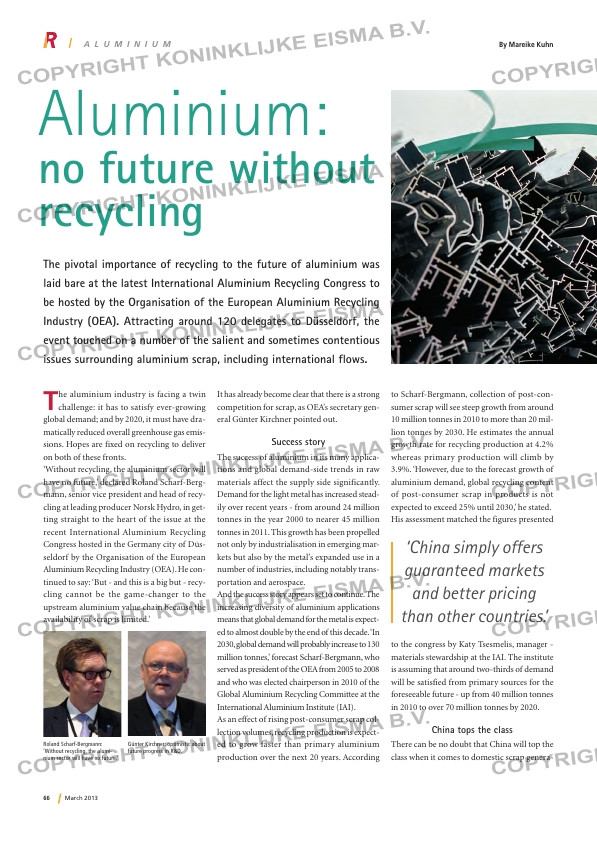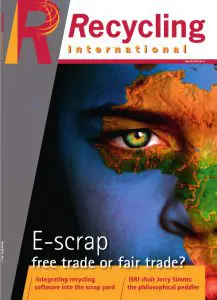Page 66 from: March 2013

66 March 2013
Aluminium:
The pivotal importance of recycling to the future of aluminium was
laid bare at the latest International Aluminium Recycling Congress to
be hosted by the Organisation of the European Aluminium Recycling
Industry (OEA). Attracting around 120 delegates to Düsseldorf, the
event touched on a number of the salient and sometimes contentious
issues surrounding aluminium scrap, including international flows.
The aluminium industry is facing a twin challenge: it has to satisfy ever-growing
global demand; and by 2020, it must have dra-
matically reduced overall greenhouse gas emis-
sions. Hopes are fixed on recycling to deliver
on both of these fronts.
‘Without recycling, the aluminium sector will
have no future,’ declared Roland Scharf-Berg-
mann, senior vice president and head of recy-
cling at leading producer Norsk Hydro, in get-
ting straight to the heart of the issue at the
recent International Aluminium Recycling
Congress hosted in the Germany city of Düs-
seldorf by the Organisation of the European
Aluminium Recycling Industry (OEA). He con-
tinued to say: ‘But – and this is a big but – recy-
cling cannot be the game-changer to the
upstream aluminium value chain because the
availability of scrap is limited.’
It has already become clear that there is a strong
competition for scrap, as OEA’s secretary gen-
eral Günter Kirchner pointed out.
Success story
The success of aluminium in its many applica-
tions and global demand-side trends in raw
materials affect the supply side significantly.
Demand for the light metal has increased stead-
ily over recent years – from around 24 million
tonnes in the year 2000 to nearer 45 million
tonnes in 2011. This growth has been propelled
not only by industrialisation in emerging mar-
kets but also by the metal’s expanded use in a
number of industries, including notably trans-
portation and aerospace.
And the success story appears set to continue. The
increasing diversity of aluminium applications
means that global demand for the metal is expect-
ed to almost double by the end of this decade. ‘In
2030, global demand will probably increase to 130
million tonnes,’ forecast Scharf-Bergmann, who
served as president of the OEA from 2005 to 2008
and who was elected chairperson in 2010 of the
Global Aluminium Recycling Committee at the
International Aluminium Institute (IAI).
As an effect of rising post-consumer scrap col-
lection volumes, recycling production is expect-
ed to grow faster than primary aluminium
production over the next 20 years. According
to Scharf-Bergmann, collection of post-con-
sumer scrap will see steep growth from around
10 million tonnes in 2010 to more than 20 mil-
lion tonnes by 2030. He estimates the annual
growth rate for recycling production at 4.2%
whereas primary production will climb by
3.9%. ‘However, due to the forecast growth of
aluminium demand, global recycling content
of post-consumer scrap in products is not
expected to exceed 25% until 2030,’ he stated.
His assessment matched the figures presented
to the congress by Katy Tsesmelis, manager –
materials stewardship at the IAI. The institute
is assuming that around two-thirds of demand
will be satisfied from primary sources for the
foreseeable future – up from 40 million tonnes
in 2010 to over 70 million tonnes by 2020.
China tops the class
There can be no doubt that China will top the
class when it comes to domestic scrap genera-
A l u m i n i u m By Mareike Kuhn
no future without
recycling
‘China simply offers
guaranteed markets
and better pricing
than other countries.’
Roland Scharf-Bergmann:
‘Without recycling, the alumi-
nium sector will have no future.’
Günter Kirchner: optimistic about
future progress in R&D.
RI_2-AluRIindd.indd 66 06-03-13 11:59



